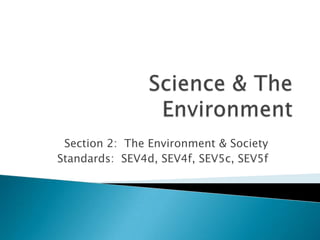
Unit 1 ch1 s2 the environment & society
- 1. Section 2: The Environment & Society Standards: SEV4d, SEV4f, SEV5c, SEV5f
- 2. Essay written by Garrett Hardin in 1968 Main idea: Problem with solving env. problems is the conflict btwn short term goals of an individual vs. the long term welfare of society.
- 3. Imagine a “common” area of land for grazing sheep. It is in the best interest of one INDIVIDUAL farmer to put as many sheep as he can on the common grazing land. That way he can make more money. HOWEVER, when ALL farmers think this way, too many sheep graze in that area and the area becomes depleted from overgrazing, trampling, etc..
- 4. Someone has to take responsibility for maintaining a resource or it can be overused & depleted. We now have grazing regulations and hunting & fishing laws to prevent resource depletion. What are some other “common” areas?
- 5. Supply & Demand ◦ If resource is limited and has greater demand then the higher its cost.
- 6. Costs-Benefit Analysis ◦ Weighing the cost of buying/producing a product vs. the benefit to the environment ◦ EX: Is fracturing the Earth to get remnant oil more beneficial even though there is a cost to the environment and drinking water sources?
- 7. Risk Assessment ◦ Usually done along with cost-benefit analysis ◦ Must determine risk to know if there is a benefit to an environmental action. ◦ Risk assessment depends on who is doing it. If done by an industry- may see less risk If done by a citizen group- may see more risk
- 8. Developed countries ◦ higher average incomes Top World Oil Consumers in 2009 ◦ slower population growth ◦ diverse industrial economies ◦ stronger social support systems ◦ EX: US, Western Europe, Japan Responsible for the “consumption crisis”- use & waste too many natural resources Use 75% of world’s natural resources BUT only makes up 20% of world’s population.
- 9. Developing countries ◦ lower average incomes ◦ simple & agricultural- based economies ◦ rapid population growth ◦ EX: Mexico, Indonesia, countries in Africa Responsible for “population crisis”- Population grows too fast for current resource level- causes malnutrition, disease, fewer jobs
- 10. China is most populated country- 1.3 billion people China is on the verge of becoming developed thanks to outsourcing and globalization. Population crisis + consumption crisis = INCREASED RESOURCE DEPLETION AND POLLUTION India (population 1.2 billion ) not far behind!
- 11. Shows the productive area of the earth needed to support one person in a particular country. Here’s Mrs. Davis’ data…
- 12. Sustainability- condition in which human needs are met in such a way that a human population can survive indefinitely. Requires participation of citizens, industries, & governments
Hinweis der Redaktion
- Examples of grazing regulations might include: limiting number of animals per acreage of land, putting up fences (like in the picture above), rotating herds from one plot to another to give used plots a chance to regenerate.Examples of hunting & fishing laws include: only catching certain species of fish, certain numbers of a species, organism has to be a certain length or gender, can only fishing during certain seasons.
- Hydraulic fracturing or “Fracking” is where water and harmful, flammable chemicals are forced under high pressure into old oil wells to crack bedrock and extract oil & natural gas remnants previously trapped there. The fracturing of the rock creates cracks that allow the chemicals to seep into groundwater sources (see top right of picture). This creates an unusable drinking water well for the people that live near these sites.
- Ask kids to rank which is riskier technology- riding bike or nuclear power. Public usually ranks nuclear power plant as most risky and experts put it 20th on the list BEHIND riding a bike. Just goes to show risk assessment depends on who you ask.
- How many countries on this list are developed vs. developing? More developed than developing.
- Make sure kids see difference between 2 blue lines. China is expected to exceed the US in CO2 emissions by 2030. This CO2 will result because more Chinese people will become affluent, buy cars & homes (they burn coal to heat their homes which releases a lot of CO2) that cause this pollution and resource depletion.